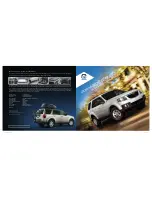
Practical tips
●
Protect face, hands and arms by cover-
ing the cap with a large, thick rag to protect
against escaping coolant and steam.
●
Always make sure you have not left any
objects, such as cleaning cloths or tools, in
the engine compartment.
●
If you have to work underneath the vehi-
cle, you must use suitable stands addition-
ally to support the vehicle, there is a risk of
accident!. A hydraulic jack is insufficient for
securing the vehicle and there is a risk of
injury.
●
If any work has to be performed when the
engine is started or with the engine running,
there is an additional, potentially fatal,
safety risk from the rotating parts, such as
the drive belts, alternator, radiator fan, etc.,
and from the high-voltage ignition system.
You should also observe the following:
–
Never touch the electrical wiring of the
ignition system.
–
Ensure that jewellery, loose clothing
and long hair do not get trapped in ro-
tating engine parts. Danger of death.
Before starting any work remove jewel-
lery, tie back and cover hair, and wear
tight-fitting clothes.
–
Never accelerate with a gear engaged
without taking the necessary precau-
tions. The vehicle could move, even if
the handbrake is applied. Danger of
death.
●
Observe the following additional warn-
ings if work on the fuel system or the elec-
trical system is necessary:
–
Always disconnect the battery from the
on-board network.
–
Do not smoke.
–
Never work near naked flames.
–
Always keep an approved fire extin-
guisher immediately available.
For the sake of the environment
●
Inspect the ground underneath your vehi-
cle regularly so that any leaks are detec-
ted at an early stage. If you find spots of oil
or other fluids in the area where it was
parked, have your vehicle inspected at the
workshop.
●
Service fluids leaks are harmful to the en-
vironment. For this reason you should make
regular checks on the ground underneath
your vehicle. If you find spots of oil or other
fluids, have your vehicle inspected in a
specialised workshop.
Note
In right-hand drive vehicles* some brake
fluid reservoirs are on the other side of the
engine compartment
.
Opening and closing the bonnet
Fig. 310
Release lever in the driver's footwell
area.
Fig. 311
Cam under the bonnet
Opening the bonnet
The bonnet is released from inside the vehi-
cle.
Before opening the bonnet, make sure that
the windscreen wiper arms are in place
against the windscreen.
350
Summary of Contents for Tarraco 2020
Page 64: ...Operation Fig 56 Instruments and controls 62 ...
Page 170: ...Infotainment System Main menus Fig 161 Menu summary 168 ...
Page 394: ...Technical data Dimensions Fig 325 Dimensions 392 ...
Page 396: ......
Page 412: ......
Page 413: ......
Page 414: ......
Page 416: ...Owner s manual SEAT Tarraco 5FJ012720BD Inglés 5FJ012720BD 11 19 SEAT Tarraco Inglés 11 19 ...
Page 417: ...Appendix to Owner s manual SEAT Tarraco FR ...
Page 418: ......
















































